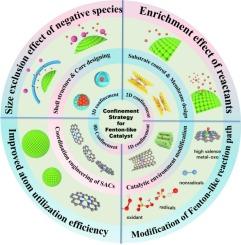Confinement strategies for the design of efficient heterogeneous Fenton-like catalysts: From nano-space to atomic scale
IF 20.3
1区 化学
Q1 CHEMISTRY, INORGANIC & NUCLEAR
引用次数: 0
Abstract
In this paper, we review the different confinement strategies of heterogeneous Fenton-like catalysts based on their important roles in catalyst design. Confinement effects can effectively promote the mass transfer ability and interference resistance of heterogeneous Fenton-like reaction processes, and modify the electronic state of the active site to enhance the Fenton-like reaction activity. In this paper, from the different confinement dimensions of the active center (including 3D, 2D, 1D and 0D), we review the effects of confinement strategies on the Fenton-like catalytic reaction in different dimensions. The influence of the morphology and type of confinement substrates on space-confined heterogeneous Fenton-like catalysts, as well as strategies for coordination modification of single-atom active sites on heterogeneous Fenton-like catalysts are described. Finally, we summarize and look forward to the challenges that still exist in the design of confinement strategies and future developing directions for heterogeneous Fenton-like catalysts.


设计高效异相芬顿类催化剂的封闭策略:从纳米空间到原子尺度
本文基于异相 Fenton 类催化剂在催化剂设计中的重要作用,综述了其不同的封闭策略。封闭效应能有效促进异相 Fenton 类反应过程的传质能力和抗干扰能力,并能改变活性位点的电子状态以提高 Fenton 类反应活性。本文从活性中心的不同禁锢维度(包括三维、二维、一维和零维)出发,综述了不同维度下禁锢策略对类芬顿催化反应的影响。介绍了封闭基底的形态和类型对空间封闭异质 Fenton 类催化剂的影响,以及对异质 Fenton 类催化剂上的单原子活性位点进行配位修饰的策略。最后,我们总结并展望了禁锢策略设计中仍然存在的挑战以及异相 Fenton 类催化剂的未来发展方向。
本文章由计算机程序翻译,如有差异,请以英文原文为准。
求助全文
约1分钟内获得全文
求助全文
来源期刊

Coordination Chemistry Reviews
化学-无机化学与核化学
CiteScore
34.30
自引率
5.30%
发文量
457
审稿时长
54 days
期刊介绍:
Coordination Chemistry Reviews offers rapid publication of review articles on current and significant topics in coordination chemistry, encompassing organometallic, supramolecular, theoretical, and bioinorganic chemistry. It also covers catalysis, materials chemistry, and metal-organic frameworks from a coordination chemistry perspective. Reviews summarize recent developments or discuss specific techniques, welcoming contributions from both established and emerging researchers.
The journal releases special issues on timely subjects, including those featuring contributions from specific regions or conferences. Occasional full-length book articles are also featured. Additionally, special volumes cover annual reviews of main group chemistry, transition metal group chemistry, and organometallic chemistry. These comprehensive reviews are vital resources for those engaged in coordination chemistry, further establishing Coordination Chemistry Reviews as a hub for insightful surveys in inorganic and physical inorganic chemistry.
 求助内容:
求助内容: 应助结果提醒方式:
应助结果提醒方式:


